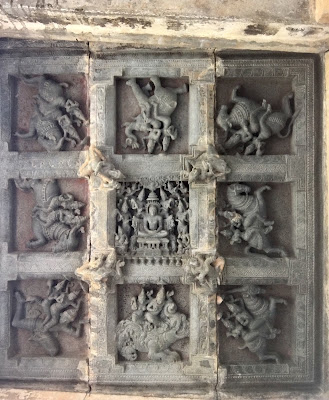Having domestic help ( "Servants" ) is considered feudalistic these days and the practice lingers on only in pockets of third world countries.
But , once upon a time , in bad old days, it was considered a mark of one's success to have many people looking after the many departments of running a household. Especially in Colonial days , the colonisers had small armies of natives serving them . The pale skinned man could have been from a riffraff background back home in England , but here , in the Colonies, he could lord it over as a White Nawab . Any wonder the land attracted fortune seekers in droves, never mind the heat and dust !
One thing to be said in their favour : the Colonisers kept meticulous records of everything they saw and experienced in the colonies . The illustrators ( painters, lithographers, engravers) did a good job of preserving for posterity scenes from their day (save a fanciful misrepresentation here and there ).
The battalions of Servants and their classification merited recording too. In late 18th Century, a Belgian print maker named Francois Balthazar Solvyns ( 1760 - 1824) came to India to make drawings of life and living in Calcutta and worked here for 13 years . He is considered one of the pioneers of Print Making in India.
His first published a collection of 250 etchings titled A Collection of Two Hundred and Fifty Coloured Etchings: Descriptive of the Manners, Customs and Dresses of the Hindoos ( Calcutta, 1796.) Unfortunately, it did not make money. for him He returned to Europe, became a diplomat, reworked his etchings and published "Les Hindoos" . This set is considered the model for the "Company Style" of Art that developed and flourished later in India.
Calendar Art , in India , is a genre by itself . Though gaudy, glossy offset prints of Gods and Filmstars were most ubiquitous on calendars , some establishments took pride in publishing good art work too. Ofcourse, at the present digital Age , it is not known if any pains are taken by anyone to make beautiful calendars that doubled as wall displays once.
Long ago, an Insurance company or some Bank( I do not remember) had brought out this calendar featuring Solvyns' gallery of Domestic helpers. It was too lovely to be discarded with old newspapers at year end, so it stayed back. With the date part cut away, and the side stapled, it looks as good as an art book. And I had saved it for almost 45 years. Couldn't bring myself to throw it away. Inspite of periodic spring cleaning sessions and house-moving , the "folio" remained with me, either stored under bed or at the bottom of the bookshelf . Its odd size was always a problem and the edges were always curling and fraying.
Eventually, Age and Time catch up. It is no longer possible to retain the Folio in good condition, nor is there the desire to hold on to it any longer . It's time to let go of things.........
But not before this shot at digitizing the old favourite !
 SARKAR : A house steward , a genius whose whole study is to handle money and to keep household accounts. KIDMUDGAR : Served meals and waited at table .
SARKAR : A house steward , a genius whose whole study is to handle money and to keep household accounts. KIDMUDGAR : Served meals and waited at table . KERCH BURDAR : Carried the loose cash for the Master and was in charge of buying small things such as fruit for the household.AUBDAR : Looked after the cellar and kept the wines cool.HOOKA BURDAR : arranged the hookah for the Master after meals and hovered around till end of session. BAULBER : The barber who shaved the Master . Only shaved, did not do hair dressing. HIRCARA : personal messenger or courier .CHOKEEDAR : Private WAtchman who paraded around the house with sword and spear till everyone was asleep. COACHMAN : chauffeurMUSHAULJEE : Torch bearer who ran with a lit torch before the Master's carriage , after dark. CHOWRY BURDAR : carried the chowri ( Yak Tail whisk), an Insignia of Rank, in front of the Master . KHAUNSAMAUN : Chief butler and Waiter at table.


























